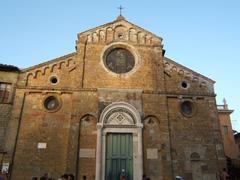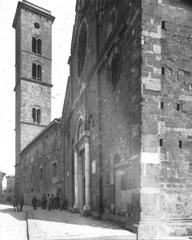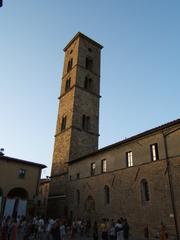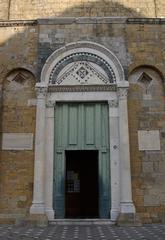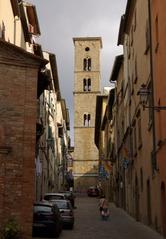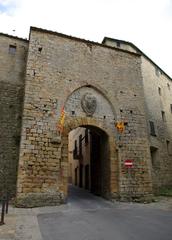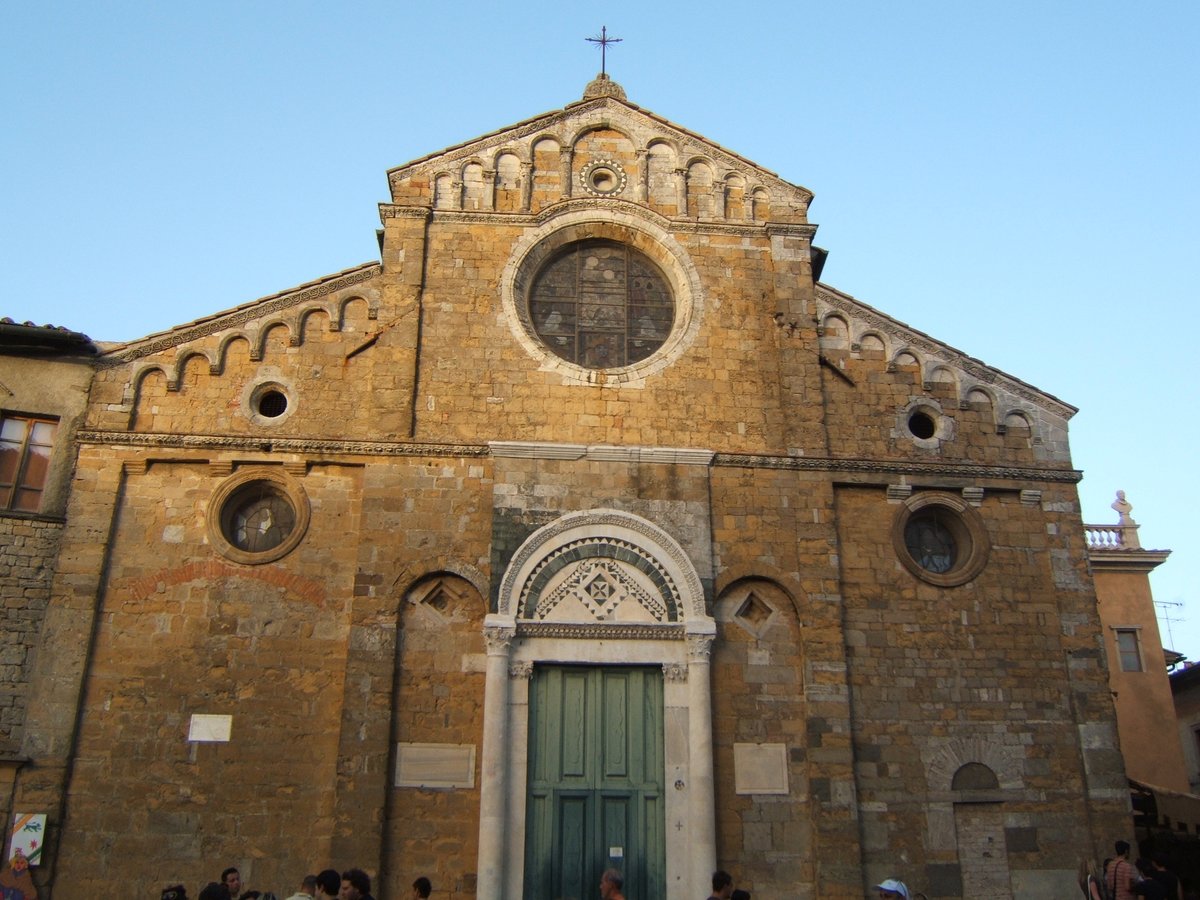
Cathedral Basilica of the Assumption of Mary Volterra Visiting Hours Tickets and Historical Significance
Date: 15/06/2025
Introduction to the Cathedral Basilica of the Assumption of Mary in Volterra including its history and cultural importance
Nestled in the historic heart of Volterra, Italy, the Cathedral Basilica of the Assumption of Mary—commonly known as the Duomo di Volterra or Volterra Cathedral—is a remarkable monument that embodies centuries of religious devotion, artistic innovation, and cultural heritage. This iconic cathedral, consecrated in 1120 by Pope Calixtus II, stands as a testament to Volterra’s resilience and spiritual significance, having risen from the ashes of earlier structures destroyed by natural disasters and conflict. Its architectural narrative spans Romanesque solidity through Gothic and Renaissance embellishments, with key contributions by renowned artists such as Nicola Pisano and Mino da Fiesole. Visitors to the Duomo di Volterra can explore its stunning façade, richly decorated interior including a grand coffered ceiling, Renaissance altars, and sacred artworks that illuminate the religious traditions of the region.
Beyond its architectural and artistic splendor, Volterra Cathedral remains a vibrant center of worship and community life, hosting important liturgical celebrations like the Feast of the Assumption on August 15th and serving as a pilgrimage site within Tuscany. Strategically perched atop a Tuscan hill, it offers panoramic views and easy access to surrounding historical landmarks such as the Baptistery of San Giovanni, the Roman Theatre, and Palazzo dei Priori, making it a must-visit destination for travelers interested in history, art, and spirituality.
This comprehensive guide provides essential information for planning your visit, including detailed visiting hours, ticketing options, accessibility considerations, and tips for exploring Volterra’s rich cultural landscape. Whether you seek to admire the cathedral’s masterpieces, attend special events, or immerse yourself in the atmospheric charm of this Tuscan gem, this resource equips you with everything needed for a memorable experience (Volterra Cathedral: Visiting Hours, Tickets, History, and Cultural Highlights; Visiting the Duomo di Volterra: Hours, Tickets, and Architectural Highlights; Volterra Cathedral Visiting Hours, Tickets, and Cultural Significance).
Table of Contents including visiting hours tickets guided tours nearby attractions and travel tips
- Introduction
- Historical Overview
- Early Origins and Medieval Foundations
- Architectural Evolution: Romanesque to Renaissance
- Artistic Treasures and Notable Features
- Chapels, Monuments, and Relics
- Later Restorations and Modern Additions
- Visitor Information
- Volterra Cathedral Visiting Hours
- Tickets and Admission
- Accessibility
- Travel Tips and Nearby Attractions
- Special Events, Guided Tours, and Photography
- Visuals and Media
- FAQ
- Conclusion
Introduction
The Cathedral Basilica of the Assumption of Mary, commonly known as Volterra Cathedral, is a magnificent historical and religious landmark located in the heart of Volterra, Tuscany. This iconic cathedral not only showcases centuries of architectural evolution and artistic treasures but also serves as a focal point for visitors exploring Volterra’s rich cultural heritage. Whether you are planning your visit to this remarkable Volterra historical site or seeking to learn more about its history and features, this guide provides essential information including visiting hours, ticket details, and tips to enhance your experience.
Historical Overview
Early Origins and Medieval Foundations
The Cathedral Basilica of the Assumption of Mary (Cattedrale di Santa Maria Assunta) stands as a testament to Volterra’s enduring religious and cultural legacy. The earliest church on this site dates back to the 9th century, dedicated to Saint Mary, although details of this initial structure are limited. Originally, the town’s cathedral was dedicated to Saint Peter but was destroyed during the Florentine siege of 1472, leading to the bishop’s seat being transferred to the current cathedral.
In 1117, a devastating earthquake destroyed much of Volterra including the church on this site. The cathedral was rebuilt and consecrated in 1120 by Pope Calixtus II. This reconstruction introduced the Romanesque architectural style, elements of which remain visible today.
Architectural Evolution: Romanesque to Renaissance
The cathedral’s façade, completed over the 12th and 13th centuries, blends Romanesque and Gothic styles, featuring a tympanum, a blind loggia, a large rose window, and a marble portal adorned with a geometric mosaic made from ancient Roman spolia. Renowned Renaissance art historian Giorgio Vasari attributed the enlargement and decoration during the 13th century to sculptor Nicola Pisano.
The interior follows a Latin cross plan with a nave and two side aisles. Between 1580 and 1584, Bishop Guido Serguidi oversaw renovations aligning the church with the Council of Trent’s liturgical reforms, resulting in a late Renaissance interior contrasting the austere exterior.
Artistic Treasures and Notable Features
Visitors to Volterra Cathedral will be captivated by its lavish interior, including a grand coffered wooden ceiling adorned with gold leaf, designed by Francesco Capriani and carved by Jacopo Pavolini, with gilding by Fulvo della Tuccia. The ceiling’s centerpiece depicts paradise featuring Volterra’s saints and the Assumption of the Virgin, surrounded by marble busts of notable saints.
The six chapels along the aisles contain 16th-century altars and late Mannerist altarpieces reflecting Counter-Reformation influences. The cathedral also houses an ancient pulpit with 12th-century bas-reliefs and a polychrome wood group depicting the Deposition of Christ, dating from the early 13th century.
A highlight is the elegant ciborium over the high altar, crafted by Mino da Fiesole in 1471. In 2019, a new alabaster altar created by local artisans was added, continuing Volterra’s tradition of sacred art.
Chapels, Monuments, and Relics
The Oratory of the Virgin Mary (Cappella dell’Addolorata) features frescoes by Benozzo Gozzoli and nearly life-size glazed terracotta figures attributed to Giovanni della Robbia. The Chapel of the Holiest Name of Jesus houses a 16th-century architectural frame, the monogram of Christ gifted by San Bernardino of Siena, and an Annunciation painting by Fra Bartolomeo della Porta.
Noteworthy is the funerary monument of Bishop Mario Maffei, sculpted by Giovanni Angelo Montorsoli, showcasing Renaissance artistry.
Later Restorations and Modern Additions
The cathedral underwent significant 19th-century restoration after an earthquake, including repainting walls with white and gray stripes, geometric marble flooring, and refinished stucco columns. A fire led to remodeling the transept in Gothic style but resulted in the loss of a 16th-century organ.
Designated a Minor Basilica in 1957, and included among the Jubilee Churches for the Extraordinary Jubilee of Mercy in 2016 and the Holy Year 2025, the cathedral remains a living monument of faith and art.
Visitor Information
Volterra Cathedral Visiting Hours
- Monday to Saturday: 10:00 AM – 5:00 PM
- Sunday and Public Holidays: 12:30 PM – 5:00 PM
- Closed on select religious holidays
Please check the official website or local tourist information for updates before your visit.
Tickets and Admission
Admission to Volterra Cathedral is free, but donations are appreciated to aid ongoing preservation efforts. Guided tours and audio guides may require a fee.
Accessibility
The cathedral is partially accessible to visitors with mobility impairments. Some areas have steps or uneven surfaces; assistance is recommended.
Travel Tips and Nearby Attractions
Volterra Cathedral is located on Piazza San Giovanni, easily accessible on foot from the town center. Nearby Volterra historical sites include the Roman Theatre, Etruscan Museum, and Palazzo dei Priori. Parking is available at designated lots outside the historic center.
Special Events, Guided Tours, and Photography
Guided tours are offered seasonally and during special events, providing in-depth exploration of the cathedral’s art and history. Photography is allowed without flash; the best spots include the nave’s central aisle, the façade’s rose window, and the alabaster altar.
Visuals and Media
Visitors can explore virtual tours and high-resolution images on the official Volterra tourism website. Physical maps and brochures are available at local tourist offices.
FAQ
Q: What are the visiting hours of Volterra Cathedral? A: The cathedral is open Monday to Saturday from 10:00 AM to 5:00 PM, and Sundays and public holidays from 12:30 PM to 5:00 PM.
Q: Is there an admission fee for Volterra Cathedral? A: Admission is free, though donations are welcomed. Guided tours and audio guides may have associated costs.
Q: How can I purchase tickets or book a guided tour? A: Tickets for guided tours can be booked online through the official Volterra tourism website or at local tourist offices.
Q: Is the cathedral accessible for visitors with disabilities? A: The cathedral is partially accessible. Some areas have steps; visitors with mobility challenges should seek assistance.
Q: Are there any special events held at the cathedral? A: Yes, the cathedral hosts religious celebrations, concerts, and art exhibitions throughout the year.
Conclusion
Volterra Cathedral is a must-visit for anyone interested in history, art, and spirituality. Its blend of Romanesque and Renaissance architecture, rich artistic heritage, and ongoing cultural significance make it a highlight among Volterra historical sites. Plan your visit today to experience this magnificent basilica firsthand.
For the latest updates on Volterra Cathedral visiting hours, tickets, special events, and tours, download the Audiala app and follow official social media channels. Explore more about Volterra’s cultural treasures through our related articles and make your visit unforgettable!
Discover the Duomo di Volterra: A Guide to Visiting Hours, Tickets, and Architectural Marvels
Nestled atop a rocky hill overlooking the Tuscan countryside, the Cathedral Basilica of the Assumption of Mary—commonly known as the Duomo di Volterra—is a must-see historical site for visitors to Volterra. This guide covers everything you need to know about visiting the Duomo di Volterra, including opening hours, ticket information, and insights into its stunning Romanesque and Renaissance architecture.
Exterior Architecture and Setting
The Duomo di Volterra is a striking example of Romanesque architecture, perched at 540 meters (1,770 feet) above sea level between the Bra and Cecina rivers. Its commanding position within the fortified walls of Volterra offers panoramic views of Tuscany and highlights its historical role as both a spiritual and civic landmark (volterra.net). The cathedral’s façade is noted for its harmonious proportions and use of local stone, including alabaster—a material for which Volterra is famous. The bell tower, rebuilt multiple times, stands adjacent to the cathedral, creating a compelling vertical accent to the horizontal layout of the nave and aisles.
Historical Layers and Construction Phases
Consecrated in 1120 by Pope Callistus II, the cathedral was built on the site of an earlier Christian church, reflecting Volterra’s enduring religious significance (volterra.net). In 1254, Andrea Pisano expanded the structure, incorporating Gothic elements while preserving its Romanesque core. Renaissance modifications in 1576 added artistic flourishes without compromising the building’s historical character. The cathedral’s fabric includes spolia—reused stones and decorative elements from prior structures—symbolizing the city’s layered history.
Interior Layout and Artistic Highlights
Inside, the Duomo follows a traditional Latin cross plan with a nave flanked by two aisles. The wooden truss roof of the nave contrasts elegantly with the cross-vaulted aisles, while the elevated transept and apse direct focus to the liturgical center. The high altar, a Renaissance masterpiece by Mino da Fiesole, features intricate carvings that bridge medieval and Renaissance styles (volterra.net).
Other artistic treasures include Luca Signorelli’s “Annunciation” and works by Benvenuto di Giovanni and Leonardo da Pistoia. The chapel of St. Paul and other side altars, such as those dedicated to St. Linus and St. Francis, showcase unique frescoes and altarpieces that reflect various devotional traditions.
Baptistery of San Giovanni
Adjacent to the cathedral, the octagonal Baptistery of San Giovanni, built in 1283, houses a stunning baptismal font by Sansovino and a ciborium by Mino da Fiesole. The baptistery’s lighting creates a serene atmosphere perfect for reflection.
Visiting Hours and Tickets
Visitors can explore the Duomo di Volterra daily from 9:00 AM to 6:00 PM, with last entry at 5:30 PM. Entrance tickets cost €5 for adults, €3 for EU citizens aged 18-25, and are free for children under 18 and residents of Volterra. Tickets can be purchased onsite or online via the official cathedral website (duomodivolterra.it) and authorized ticket platforms to avoid queues.
Guided Tours and Special Events
Guided tours are available daily at 10:00 AM and 3:00 PM, offering in-depth insights into the cathedral’s history, art, and architecture. Special events, such as religious festivals and concerts, are held throughout the year; visitors should check the cathedral’s event calendar online for the latest updates.
Accessibility and Visitor Tips
The Duomo di Volterra is wheelchair accessible via ramps at the main entrance, and accessible restrooms are available. Information panels and multilingual guides enhance the visitor experience. Photography is permitted in most areas; however, visitors are kindly asked to respect the sanctity of the space, especially during services.
Nearby Attractions
The cathedral is part of an architectural ensemble that includes the Palazzo dei Priori and the Piazza dei Priori, offering visitors a comprehensive experience of Volterra’s rich heritage. The nearby Etruscan Museum and Roman Theatre are also highly recommended for history enthusiasts.
Frequently Asked Questions (FAQ)
What are the visiting hours of Duomo di Volterra? The cathedral is open daily from 9:00 AM to 6:00 PM, with last entry at 5:30 PM.
How can I buy tickets for the Duomo di Volterra? Tickets are available onsite or online through the official website (duomodivolterra.it) and authorized platforms.
Is the Duomo di Volterra wheelchair accessible? Yes, ramps and accessible facilities are provided.
Are guided tours available? Yes, guided tours take place daily at 10:00 AM and 3:00 PM.
Can I take photographs inside the cathedral? Photography is allowed in most areas but please be respectful during religious services.
Conclusion
The Duomo di Volterra offers visitors a captivating blend of historical significance, architectural beauty, and spiritual ambiance. Whether you are an art lover, history buff, or casual traveler, exploring this Tuscan gem is an unforgettable experience. Plan your visit today by checking the official website for the latest information on hours, tickets, and special events.
For more travel tips and updates on Volterra’s historical sites, download the Audiala app and follow us on social media. Don’t miss out on discovering the rich cultural heritage of this enchanting Tuscan town!
Images:
- Include high-quality photos of the Duomo’s façade, interior, high altar, and Baptistery with alt tags such as “Duomo di Volterra façade at sunset,” “Interior of Duomo di Volterra with high altar by Mino da Fiesole,” “Baptistery of San Giovanni in Volterra.”
Links:
- Official Duomo di Volterra website: http://www.duomodivolterra.it
- Volterra tourism information: https://www.volterra.net/
- Related articles on Tuscan historical sites (internal links)
Map and Virtual Tour:
- Embed a map showing the Duomo’s location in Volterra
- Link to any available virtual tours or video walkthroughs
Introduction
The Cathedral Basilica of the Assumption of Mary, also known as Volterra Cathedral (Cattedrale di Santa Maria Assunta), is a must-visit historical site in Volterra, Italy. Renowned for its religious importance, stunning architecture, and rich artistic heritage, the cathedral offers visitors a unique glimpse into the spiritual and cultural history of this charming Tuscan city. This guide covers everything from visiting hours and ticket information to the cathedral’s religious, cultural, and artistic significance, ensuring you make the most of your visit.
Dedication and Liturgical Role
The Volterra Cathedral stands as the spiritual heart of the city, dedicated to the Assumption of the Virgin Mary—a central belief in Catholicism celebrating Mary being taken bodily into heaven. This dedication is evident in the cathedral’s liturgical calendar, with the Feast of the Assumption on August 15th being a major annual event. On this day, locals and visitors alike participate in solemn Masses and processions (terredipisa.it). The cathedral remains an active place of worship, hosting daily services, sacraments, and community gatherings, maintaining its role as a vibrant center of Catholic devotion.
Historical Continuity and Transformation
Founded around 1120 on the site of an earlier church destroyed by an earthquake, Volterra Cathedral symbolizes resilience and the enduring presence of Christianity in the region (terredipisa.it). It has undergone multiple renovations, particularly in the 13th and 16th centuries, reflecting changing religious and artistic trends. Notably, Nicola Pisano contributed to the Pisa Romanesque façade, underscoring the cathedral’s importance as a religious and cultural landmark (earthtrekkers.com).
Architectural Symbolism and Sacred Art
The cathedral features a Latin cross plan with three naves separated by 22 granite columns and black-and-white striped walls, creating an atmosphere of grandeur and solemnity typical of major Catholic basilicas (terredipisa.it). The pulpit, reconstructed from original 12th-century elements, and the wooden Deposition group (1228), a masterpiece of Romanesque sculpture, invite contemplation on the Passion of Christ.
Its grand coffered ceiling adorned with geometric motifs and numerous chapels decorated with sacred art serve as a visual catechism. Busts of local saints such as Ugo, Giusto, San Lino (a Pope), Clemente, Attinia, and Greciniana highlight the cathedral’s role in fostering local religious identity (terredipisa.it).
Pilgrimage and Community Identity
Volterra Cathedral is a pilgrimage destination for Catholics regionally and beyond. Its status as a basilica highlights its ecclesiastical importance and role in significant diocesan events. It is part of Italy’s rich tradition of Marian devotion, attracting pilgrims seeking spiritual renewal (budgetyourtrip.com).
The cathedral plays a central role in Volterra’s cultural identity, especially during major religious festivals like the Feast of the Assumption, celebrated with processions, music, and communal gatherings that blend faith with local traditions.
Artistic Heritage and Cultural Influence
The Pisa Romanesque façade by Nicola Pisano and the late Renaissance interior exemplify the blend of religious purpose and artistic innovation (terredipisa.it). The wooden Deposition group and intricately decorated chapels attract art historians and enthusiasts, making the cathedral a cultural tourism highlight.
Its proximity to the Baptistery of San Giovanni Battista and other historic churches forms a sacred precinct embodying Volterra’s religious and cultural history (earthtrekkers.com). The cathedral also safeguards sacred art and relics, enhancing its role as guardian of the city’s spiritual patrimony.
Educational and Social Functions
In addition to worship, the cathedral offers educational tours that explore its history, architecture, and religious significance (budgetyourtrip.com). It hosts concerts, lectures, and community events, reflecting its integration into Volterra’s social life. The cathedral welcomes visitors of all ages and backgrounds, including families and budget travelers.
Visitor Information: Visiting Hours, Tickets, and Accessibility
- Visiting Hours: The cathedral is generally open daily from 10:00 AM to 6:00 PM, but hours may vary seasonally or during religious events. Visitors are advised to check official sources or local tourism offices before planning their visit.
- Tickets: Entry costs €11, which includes access to the cathedral and its artistic treasures. Guided tours are available for an additional fee and are highly recommended for a comprehensive experience (budgetyourtrip.com).
- Photography: Photography inside the cathedral is not allowed to respect the sanctity of the space and preserve artworks (earthtrekkers.com).
- Accessibility: The cathedral is located in Piazza San Giovanni, easily reachable on foot from Volterra’s historic center. While the building is accessible to most visitors, those with mobility impairments should inquire locally about specific accommodations.
- Tips for Visitors: To avoid crowds, especially during peak tourist seasons, it’s best to visit early in the morning or late in the afternoon.
Visuals and Media
Visitors can enjoy high-quality images of the cathedral’s façade, interior, and artworks on official tourism websites. Some sites also offer virtual tours or maps to enhance planning and on-site experience.
Related Attractions and Internal Links
Frequently Asked Questions (FAQ)
Q: What are the exact visiting hours of Volterra Cathedral? A: Typically 10:00 AM to 6:00 PM daily, but hours may change seasonally or during special events.
Q: How much does a ticket cost? A: Entry is €11 per person, with optional guided tours for an extra fee.
Q: Is photography allowed inside? A: No, photography is prohibited inside to protect the sacred space and artworks.
Q: Is the cathedral accessible for people with disabilities? A: The cathedral is centrally located and largely accessible, but visitors should check locally for specific accommodations.
Q: When is the best time to visit? A: Early mornings or late afternoons during off-peak seasons provide a more peaceful experience.
Conclusion
Volterra Cathedral is a captivating blend of faith, history, art, and community life. Whether you’re drawn by its religious significance, architectural beauty, or cultural heritage, a visit promises an enriching experience. Plan your visit by checking current hours and ticket options, and take advantage of guided tours to fully appreciate this remarkable historical site.
For more travel tips and updates on Volterra’s cultural treasures, download the Audiala app, explore our related posts, and follow us on social media. Your journey into Volterra’s rich past and vibrant present awaits!
Discover the Duomo of Volterra: Visiting Hours, Tickets, and Exploring Volterra Historical Sites
The Cathedral Basilica of the Assumption of Mary, commonly known as the Duomo of Volterra, is a must-visit landmark in the heart of Volterra’s historic center. This guide offers comprehensive information on visiting hours, ticketing, architectural highlights, and tips for exploring Volterra’s rich historical sites.
Alt text: Duomo of Volterra Romanesque façade featuring alternating stone and marble bands
Approaching the Cathedral: Location and Setting
Situated adjacent to Piazza San Giovanni and near the main square, Piazza dei Priori, the Duomo of Volterra offers visitors easy access to several Volterra historical sites. Its central location within the pedestrianized zone encourages visitors to explore nearby attractions such as the Baptistery of San Giovanni and the Palazzo dei Priori, making it ideal for walking tours (The Geographical Cure).
Architectural and Artistic Impressions
Upon arrival, the cathedral’s striking 12th-century Romanesque façade captures attention with its distinctive alternating bands of stone and marble, a classic feature of Tuscan Romanesque architecture. The intricately carved portal and the 15th-century bell tower create a picturesque silhouette against the Tuscan sky.
Inside, visitors encounter a blend of Romanesque and Gothic styles. The nave is lined with grand columns, and the coffered ceiling, enhanced during Baroque renovations, complements the soft natural light from stained glass windows. Key artworks include frescoes, altarpieces, and a finely carved wooden pulpit.
Duomo of Volterra Visiting Hours and Tickets
- Visiting Hours: The Duomo of Volterra is generally open from 9:00 AM to 6:00 PM, with shorter winter hours and occasional closures during religious services. Spring and fall offer the best visiting conditions with fewer crowds and mild weather.
- Tickets: Admission to the cathedral is usually free, though donations are welcomed to support maintenance. For a full experience, visitors can purchase the combined “Volterra Card,” which includes entrance to the cathedral, Baptistery, and other historical sites (The Geographical Cure).
- Guided Tours: Audio guides and guided walking tours are available in multiple languages, enhancing understanding of the cathedral’s history and art.
Visitor Flow, Accessibility, and Parking
The main entrance to the cathedral involves a short flight of steps, and while the historic structure presents some accessibility challenges, staff are helpful and can assist visitors with mobility needs. The Duomo lies within Volterra’s pedestrian zone, so parking is available outside the city walls at Porta a Selci and Porta Fiorentina, both about a 10-minute walk away. Comfortable walking shoes are recommended due to cobbled and sometimes steep streets.
Highlights of the Visitor Experience
The Main Nave and Side Chapels
The spacious main nave inspires awe with its grandeur and tranquility. Side chapels contain significant religious artworks, including Renaissance paintings and sculpted altars. The Chapel of the Madonna, featuring a revered 13th-century icon of the Virgin Mary, is especially notable.
The High Altar and Choir
Marvel at the marble craftsmanship of the high altar, flanked by elaborately carved choir stalls. Frescoes behind the altar depict scenes from the Virgin Mary’s life, underscoring the cathedral’s dedication. The choir area frequently hosts liturgical music rehearsals and performances.
The Baptistery of San Giovanni
Opposite the Duomo, the octagonal Baptistery presents a stark Romanesque exterior contrasted with a richly decorated interior, including a monumental baptismal font and frescoes. Entry is often included with the Volterra Card.
Alt text: Interior of the Baptistery of San Giovanni with frescoes and baptismal font
The Bell Tower
For panoramic views, visitors can climb the bell tower when open. The narrow staircase leads to breathtaking vistas over Volterra’s rooftops and the Tuscan countryside, ideal for those comfortable with heights.
Practical Information for Visitors
Dress Code and Etiquette
As an active place of worship, modest attire covering shoulders and knees is required. Visitors should maintain quiet, especially during services, and photography is allowed without flash or tripods.
Facilities and Amenities
- Restrooms are located nearby but not inside the cathedral.
- A gift shop next to the cathedral offers religious souvenirs, guidebooks, and local alabaster crafts.
- Accessibility is limited in some areas, such as the bell tower.
Seasonal Considerations and Special Events
Spring (April–June) and fall (September–October) are ideal for visiting due to pleasant weather and smaller crowds. Summer brings more visitors, especially during local festivals. The cathedral hosts concerts, organ recitals, and special liturgical events, enriching the cultural experience.
Cultural Insights and Local Significance
The Duomo is a symbol of Volterra’s heritage, reflecting centuries of devotion and artistry. It plays an essential role in community life, notably during the Feast of the Assumption on August 15th, featuring processions and special masses.
Engaging with local guides or attending services can deepen appreciation of the cathedral’s spiritual and cultural importance.
Frequently Asked Questions (FAQ)
Q: What are the Duomo of Volterra visiting hours?
A: Typically from 9:00 AM to 6:00 PM, with shorter hours in winter and occasional closures during services.
Q: Are there tickets required to enter the cathedral?
A: Entry is usually free, but donations are encouraged. The Volterra Card offers combined access to the Duomo, Baptistery, and other sites.
Q: Is the cathedral accessible for visitors with mobility issues?
A: The main nave is accessible, but some areas like the bell tower may be challenging. Staff assistance is available.
Q: Where can I park when visiting the Duomo of Volterra?
A: Parking is outside the city walls at Porta a Selci and Porta Fiorentina, about a 10-minute walk from the cathedral.
Q: Are guided tours available?
A: Yes, audio guides and walking tours in multiple languages are offered.
Tips for a Memorable Visit
- Arrive early to enjoy the cathedral before peak crowds.
- Combine your visit with nearby historical sites for a comprehensive walking tour.
- Capture photos in early morning or late afternoon light for the best results.
- After your visit, enjoy Tuscan cuisine at nearby trattorias with views of the cathedral and piazzas.
For the latest updates on opening hours and events, visit the official Volterra tourism website or the Geographical Cure travel guide.
Enjoyed this guide? Download the Audiala mobile app for exclusive audio tours and insider tips on Volterra’s historical sites. Follow us on social media for the latest updates and travel inspiration!
Summary of key points about visiting the Cathedral Basilica of the Assumption of Mary and final recommendations
The Cathedral Basilica of the Assumption of Mary in Volterra stands as a captivating fusion of faith, history, and artistry, offering visitors an immersive journey into the spiritual and cultural soul of this Tuscan town. From its Romanesque foundations through Renaissance transformations, the Duomo di Volterra showcases architectural mastery and houses invaluable sacred art, including masterpieces by Nicola Pisano and Mino da Fiesole. Its role as an active place of worship and pilgrimage, coupled with its position at the heart of Volterra’s historical precinct, enriches its significance beyond that of a mere monument.
Visitors are encouraged to take advantage of guided tours, seasonal events, and the surrounding historical sites to fully appreciate the cathedral’s multifaceted heritage. Practical details such as visiting hours, ticketing (ranging from free entry with donations to modest fees), accessibility options, and visitor tips ensure an informed and enjoyable experience. Whether exploring the intricate interior artworks, ascending the bell tower for sweeping Tuscan vistas, or participating in vibrant local celebrations, a visit to the Duomo di Volterra promises a deeply rewarding encounter with Italy’s religious and cultural legacy.
For the most current information on visiting hours, ticket purchase, special events, and guided tours, prospective visitors should consult the official cathedral and tourism websites. Additionally, downloading the Audiala app and following social media channels can provide valuable updates and exclusive content to enrich your exploration of Volterra’s treasures (Duomo di Volterra official website; Volterra tourism information; Terre di Pisa - Volterra Cathedral). Embark on your journey to Volterra’s cathedral and uncover the timeless beauty and spiritual resonance that await within this remarkable basilica.
References and external links to official sites and further reading
- Volterra Cathedral: Visiting Hours, Tickets, History, and Cultural Highlights, 2025, https://www.volterra.net/
- Visiting the Duomo di Volterra: Hours, Tickets, and Architectural Highlights, 2025, https://www.volterra.net/
- Volterra Cathedral Visiting Hours, Tickets, and Cultural Significance, 2025, Terre di Pisa https://www.terredipisa.it/en/attrazione/volterra-cathedral/
- Duomo of Volterra Visiting Hours, Tickets, and Guide to Volterra Historical Sites, 2025, The Geographical Cure https://www.thegeographicalcure.com/post/one-day-in-volterra-itinerary
- Earth Trekkers, Best Things to Do in Volterra, Italy, 2025, https://www.earthtrekkers.com/best-things-to-do-in-volterra-italy/
- Budget Your Trip, Volterra Cathedral Worth Visiting?, 2025, https://www.budgetyourtrip.com/italy/volterra/volterra-cathedral-worth-visiting/205
